If your content is all things to all people, you’re doing it wrong. You’ll know it deep in your soul because it will feel wrong.
For the less woo-woo-inclined, Google Analytics won’t sugarcoat anything when you’re doing content wrong. Just look at how your content is performing. Your business results will also bluntly reveal when your efforts are falling flat.
If your content isn’t attracting and converting quality leads, then it’s time to revisit your content strategy.
The key is to use buyer stages to create content for specific buyers who need a specific solution at a specific point in their journey.
One of the most glorious things about B2B content marketing is that it’s never about mass appeal. It’s the polar opposite of “be all things to all people.”
Instead, B2B content marketing is about “meaning something to the right people.”
Does the Buyer’s Journey Still Matter?
Abso-freaking-lutely.
In a business world overrun by jargon like “disruption” and “innovation,” there is something undeniably soothing about holding on to traditions. First invented by advertising advocate Elias St. Elmo Lewis in 1898, marketing funnels are still, in fact, being used today.
Funnels and buying stages are used interchangeably as they describe the same foundational concepts of marketing. Since these concepts have been around for over a century, you will see tons of name variations based on the stages of the buyer’s journey.
The names of the stages of the buyer’s journey will vary, yet the foundational concepts will remain the same.
In 1898, Elias gave us the AIDA Model, which includes these four buyer stages:
- Attention – Top of the funnel (Early Stage)
- Interest – Top of the funnel / Middle of the funnel (Early-Mid Stage)
- Desire – Middle of the funnel (Mid Stage)
- Action – Bottom of the funnel (Late Stage)
So, why are we still talking about this? How is an invention from over a century ago relevant to B2B organizations today?
As long as people are making decisions, a decision-making process must still happen.
That process may not be wrapped up in a neat and predictable package, like a linear left-to-right progression of steps in the buyer’s journey or flowing serenely from top to bottom in a funnel. The buyer may come in and out at different moments of that journey.
But the point is that they are on that journey, and you must guide them along the way.
The 5 Stages of the Buyer’s Journey
Depending on who you talk to, there are anywhere from 3-5 buyer’s journey stages. Three buyer stages are popular, but we recommend mapping out your B2B buyer personas into five stages.
At Superneat, we identify the buyer’s journey stages as:
- Awareness (Early Stage)
- Interest (Early-Mid Stage)
- Consideration (Mid Stage)
- Decision (Late Stage)
- Support (Post-Sales)
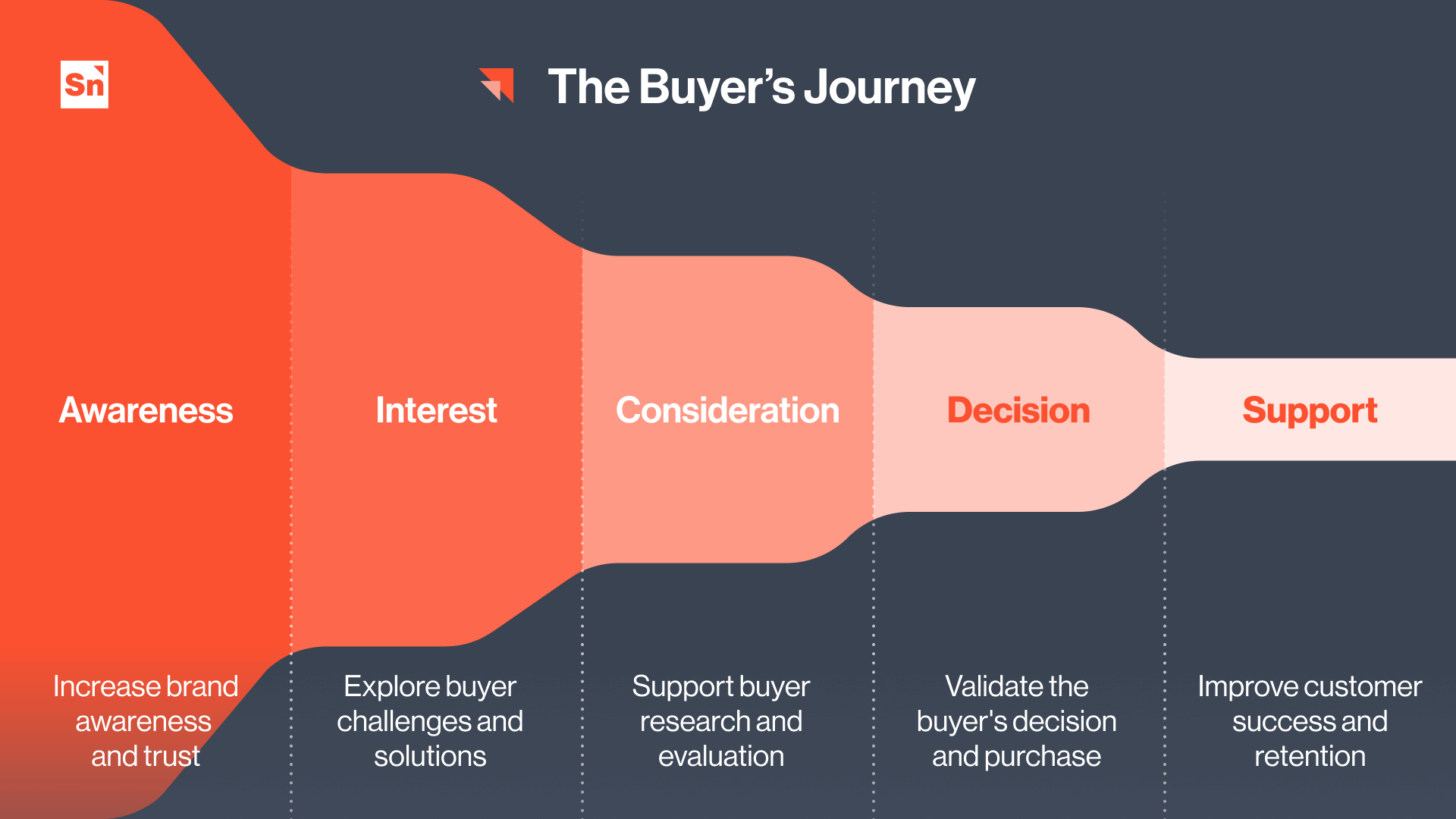
When organizations only use three buyer’s journey stages, it’s usually some variation of Awareness, Consideration, and Decision.
The second Interest stage is less common but one we felt compelled to adopt from Elias’ AIDA Model circa 1898. It’s a blended content approach (Awareness/Consideration) where we explore the buyer’s problem and introduce a solution. Here at Superneat, we find that Interest content works really well for our clients (we go into more details below if you’re intrigued by this idea).
The fifth Support stage is very often overlooked as it relates to the point after the buyer becomes a customer. Arguably, this final stage is one of the most important to focus on, as it means creating content to support and retain your customers.
Let’s take a look at all five stages of the buyer’s journey in an absurd amount of detail so you get how this stage-centric approach works within the greater context of your content marketing strategy.
Awareness: Increase Brand Awareness and Trust
Your buyer has access to more information than ever before. And, surprise, they’re overwhelmed. They don’t know where to find the information they need, and they don’t know who to trust. This Awareness stage of the buyer’s journey is your opportunity to create content that increases brand awareness and trust.
During this early stage, your buyer asks:
Will you help me understand what the hell is happening here?
Include informational and inspirational content that helps your audience fully understand their problem so they can start to understand how to solve it. Don’t jump to conclusions by serving up content that is too solution-focused as it will only further overwhelm them so early in the buying process.
Provide useful and engaging information without being self-serving or sales-y. That way, when that person is finally ready to buy, you are the resource they have already been turning to. And, guess what? That person will be much more likely to consider your product or service when they have budget approval to purchase a solution.
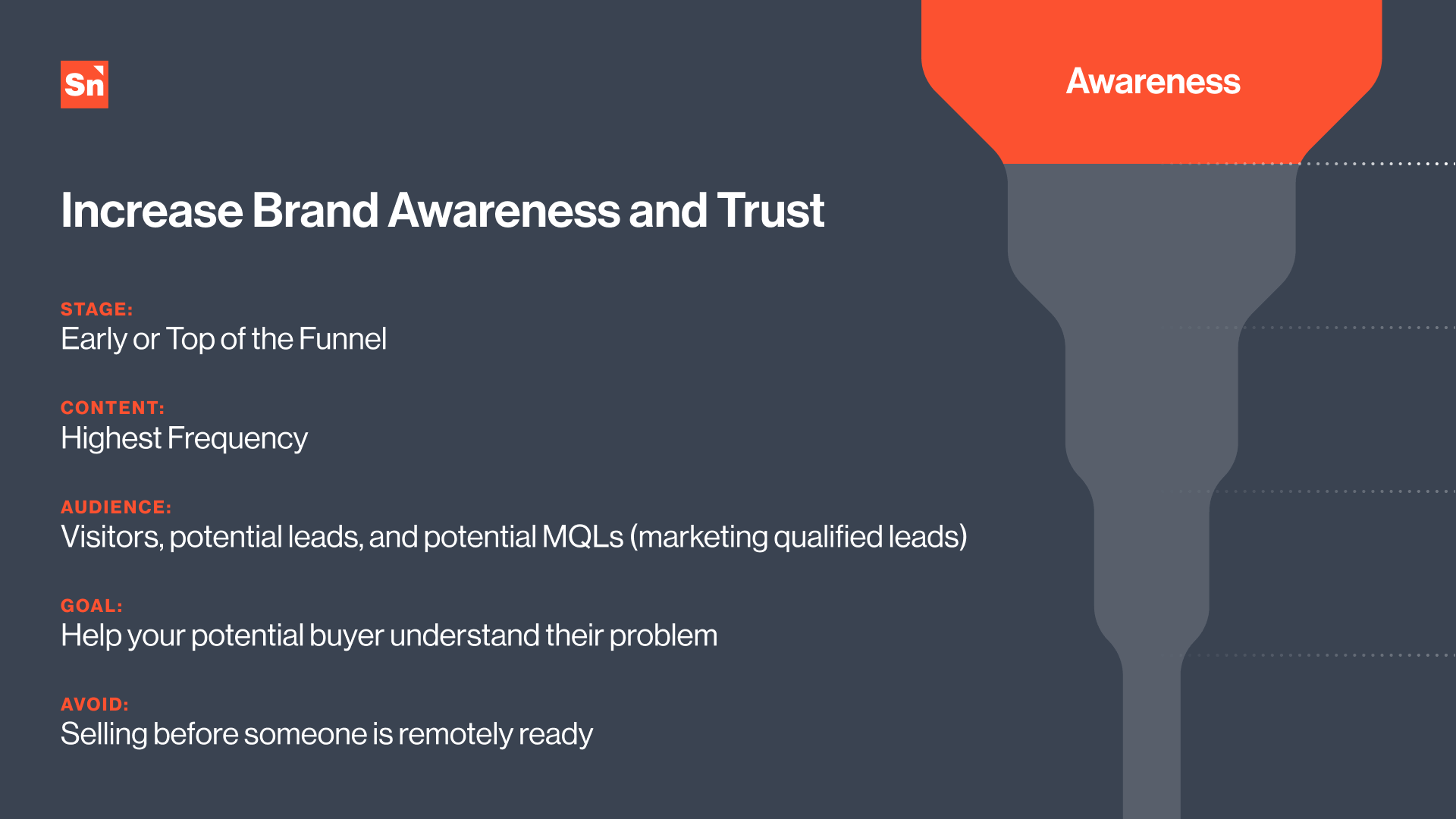
Awareness Content Ideas
Thought leadership video
Blog post
Social media post
Checklist
Cheat sheet
Press release
Infographic
Interactive quiz
Research report
101 webinar
101 podcast
101 ebook
101 courses (shorter length)
Interactive tools (i.e. generators, analyzers)
Awareness Content Example
For our first example, I have to spotlight just one of the many wonderful thought leadership videos that Salt Security is creating to serve as a resource for their community. Salt Security is all about helping people “get smarter” about API security. Thought leadership is baked right into their tagline, and they run with this theme throughout their content and videos.
Chances are pretty darn high that if you have “why” or “how to” in a video title, this marketing video is meant for someone in the earliest part of the funnel still trying to find their way. How can you help them? By sharing best practices that show them the way.
Salt Security’s video, “Why API Attacks Are Different and How to Prevent Them,” opens their audience’s eyes to the challenges posed by API attacks so they can figure out the best strategies to protect their organization. The video ends with a CTA to download the corresponding eBook so people can dig deeper into more best practices.
Interest: Explore Buyer Challenges and Solutions
Marketing funnels in the modern world take into account the fact that all leads don’t necessarily progress in a predictable and linear fashion (Stage 1, 2, 3).
Since a lead might enter and exit any stage at any point in time, creating content that blends approaches from two stages isn’t a bad idea, right? That’s the beauty of the second Interest stage of the buyer’s journey.
During this early-mid stage, your buyer asks:
Will you discuss common challenges and recommend a way to overcome them?
A blend of Awareness and Consideration, this content is educational with some solution-focused content sprinkled in. This content leans more on the Awareness side with informational and inspirational content, but it doesn’t hold back with solution recommendations.
For Superneat clients, this Interest stage is where we focus the majority of our content efforts. It’s a great way to plant the seed for early-stage buyers and be ready with an answer to their problems in case they’re starting to research solutions.
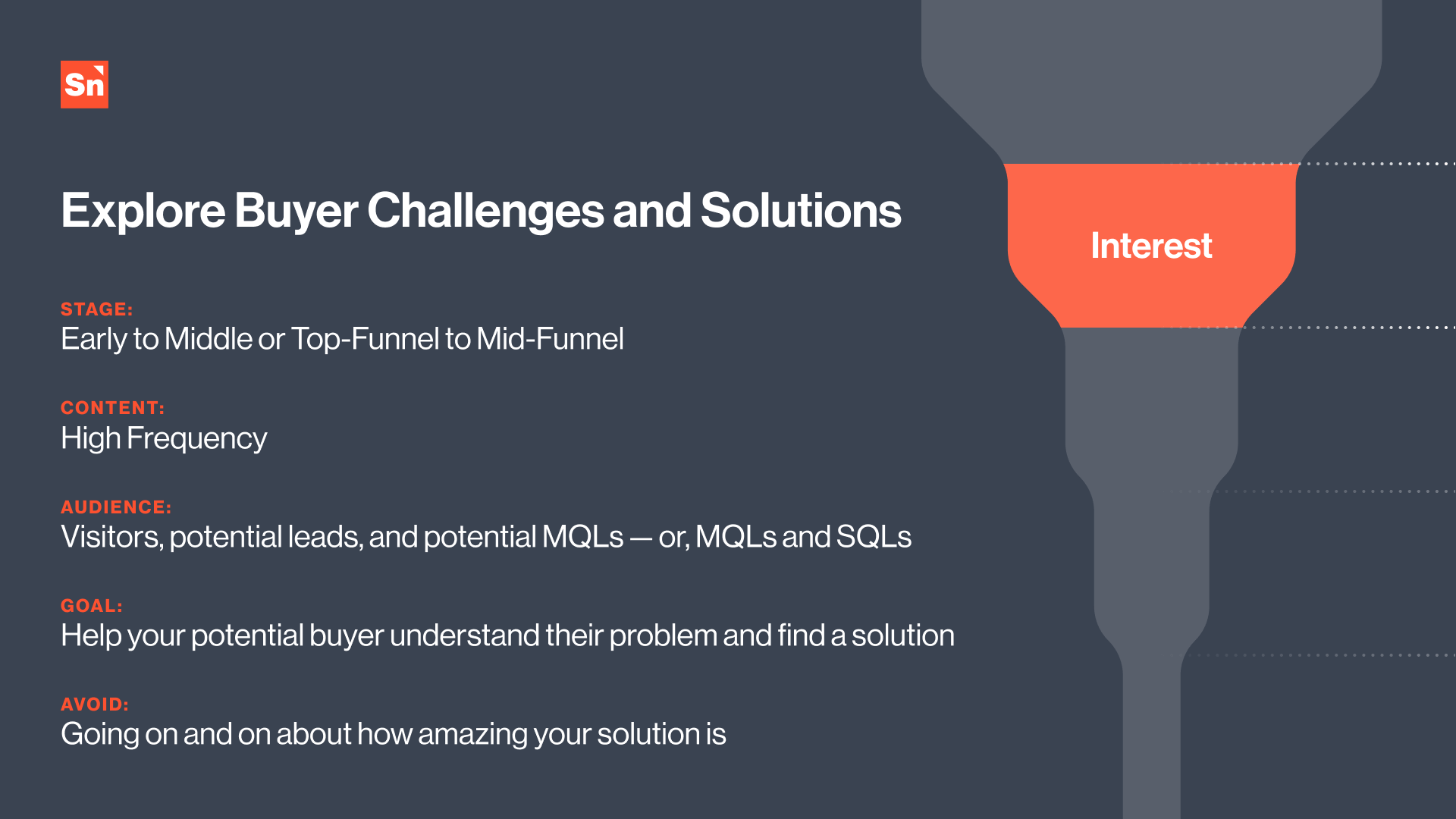
Interest Content Ideas
Use the same Awareness content types as your foundation, then add a dash of Consideration content somewhere in the second half of the piece.
For example, reference a case study halfway through a blog that discusses similar customer challenges. At the end of that same blog, embed the accompanying case study video to reinforce and validate your solution through the voice of one of your customers.
Thought leadership video
Blog post
Social media post
Checklist
Cheatsheet
Press release
Infographic
Interactive quiz
Research report
101 webinar
101 podcast
101 ebook
101 courses (shorter length)
Interactive tools (i.e. generators, analyzers)
Interest Content Example
To understand what this hybrid buying stage might look like, watch this other Salt Security video from their Salt Labs team. With well over 5K views on YouTube, this popular “Booking.com Account Takeover” video skilfully blends Awareness and Consideration content in an informative video for buyers who are in between stages.
Clocking in just shy of the 2-minute mark, this playful video explains how Salt Labs researchers pinpointed several critical security flaws on the Booking.com website.
This Interest stage video content presents a cautionary tale about what will happen if these issues are not fixed (Awareness content) while simultaneously demonstrating Salt Labs’ expertise in identifying and resolving these issues (Consideration content).
Consideration: Support Buyer Research and Evaluation
Your competitors are never far behind. Depending on the competitiveness of your industry, they may be right on your heels. If you don’t engage with your buyers in a way that serves them at this stage, your competitors will be standing there with open arms. This next Consideration stage of the buyer’s journey is your chance to support buyer research and evaluation.
During this middle stage, your buyer asks:
Will you show me why your solution is better than someone else’s?
Consideration content must make the buying experience straightforward. This person knows their problem intimately, and they are window-shopping for a solution that will make their life easier.
You don’t want to miss the mark by rehashing their problems without discussing viable solutions. You also don’t want to push people too hard and push them away. One of your best bets at this stage is to focus on use cases and customer success stories, so the buyer can relate and know that your solution is the right fit for them.
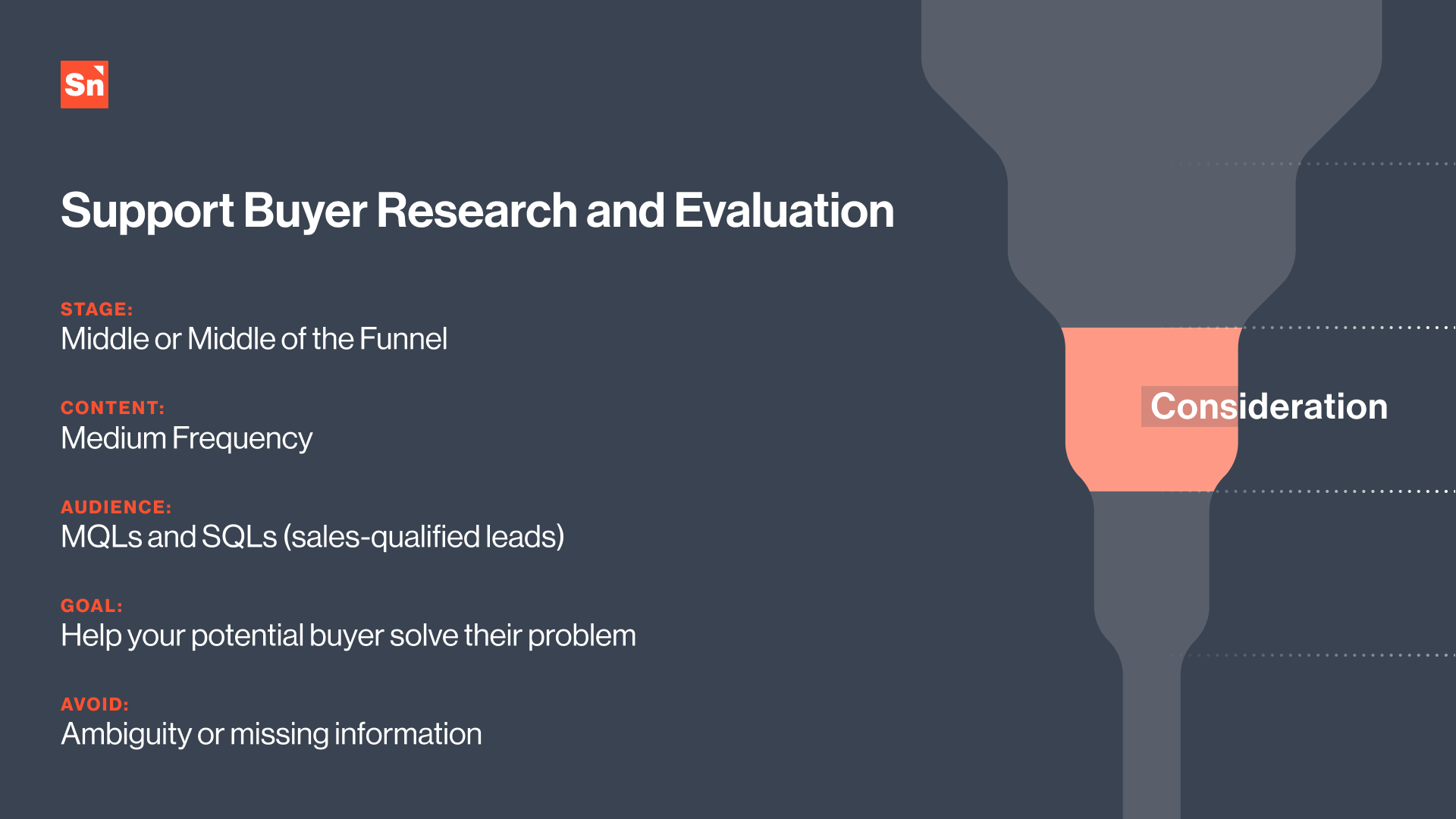
Consideration Content Ideas
Case study
Customer story
Customer interview
Customer video
Testimonial
Product review
Expert guide
Solution comparison
Use cases
In-depth webinar
In-depth podcast
In-depth video
In-depth courses (longer length)
Website
Landing page
Consideration Content Example
If I had to pick my top Consideration content idea from the list above, a case study wins every time. Case studies are an unbeatable way to communicate your solution’s value through your customer’s voice.
Check out this great video case study example from SkyPoint Cloud with their customer, Fortis Construction. Here is the written case study with the embedded video as well.
A case study traditionally covers the challenge, solution, experience, and impact. This traditional case study flow is tough to beat when portraying a customer’s success story.
What we always recommend is to go big with case studies, as they are some of the richest and most impactful Consideration content you can possibly produce. For our clients, that means investing in video and creating a companion written piece as well.
Decision: Validate the Buyer’s Decision and Purchase
By this point, your buyer has officially reached “buyer status.” This late in the buying process, once the choice is made, your lead will become your long-term customer or someone else’s. The Decision stage of the buyer’s journey is your last chance to validate their decision and purchase.
During this late stage, your buyer asks:
Will you help me feel good about this purchase and avoid buyer’s remorse?
Content at this critical point should be persuasive and product-focused. To fully support this buyer, interactions must be friction-free so they feel confident and don’t hesitate to buy.
Think of the Decision stage as a match point—whoever wins this point wins the match. This person has explored all the pros and cons of various solutions and narrowed them down to a small selection. Decision content eases any lingering hesitations and positions your organization as the clear partner choice.

Decision Content Ideas
Explainer video
Assessment
Consultation
Demo
Trial
ROI calculator
Implementation guide
Pricing sheet
Product info
FAQs
Decision Content Example
A classic Decision video content example in the B2B space is, of course, the explainer video. Kick back with this 60-second explainer we co-produced with another marketing agency, Blue Seedling, for their client, MediaFlows.
Explainers are difficult to get right because you have a teeny-tiny amount of time to present a truckload of information about your solution. While scripting this explainer, a lot of attention was spent nailing MediaFlows’ value proposition so we had the perfect intro hook to draw someone in.
You’ll see in this explainer video that we got to the point and rapidly appealed to their customer’s most important needs. We also worked hard to minimize the focus on technical wizardry and focus predominately on the business value.
Support: Improve Customer Success and Retention
After your organization closes the sale, the door should never close on your customer. They are opening a new door, moving into another phase of their journey where their success depends on the continued value of your solution or service. This final Support stage of the buyer’s journey is your shot at improving customer success and retention.
During this post-sales stage, your buyer asks:
Will you continue to support me and never stop proving your value?
Support content focuses on customer empowerment, helping them get the most out of your solution and your team. This content shows the high level of commitment your customers expected to see when they chose your organization over another. With Support content, you deepen the relationship, develop brand loyalty, and endlessly validate their purchase decision.
Sadly, the final stage is often omitted from the buyer’s journey, or if it is included, it is often overlooked in content strategies. This is a major misstep, as you risk losing your customer when you don’t demonstrate that you value their happiness and success above everything else.
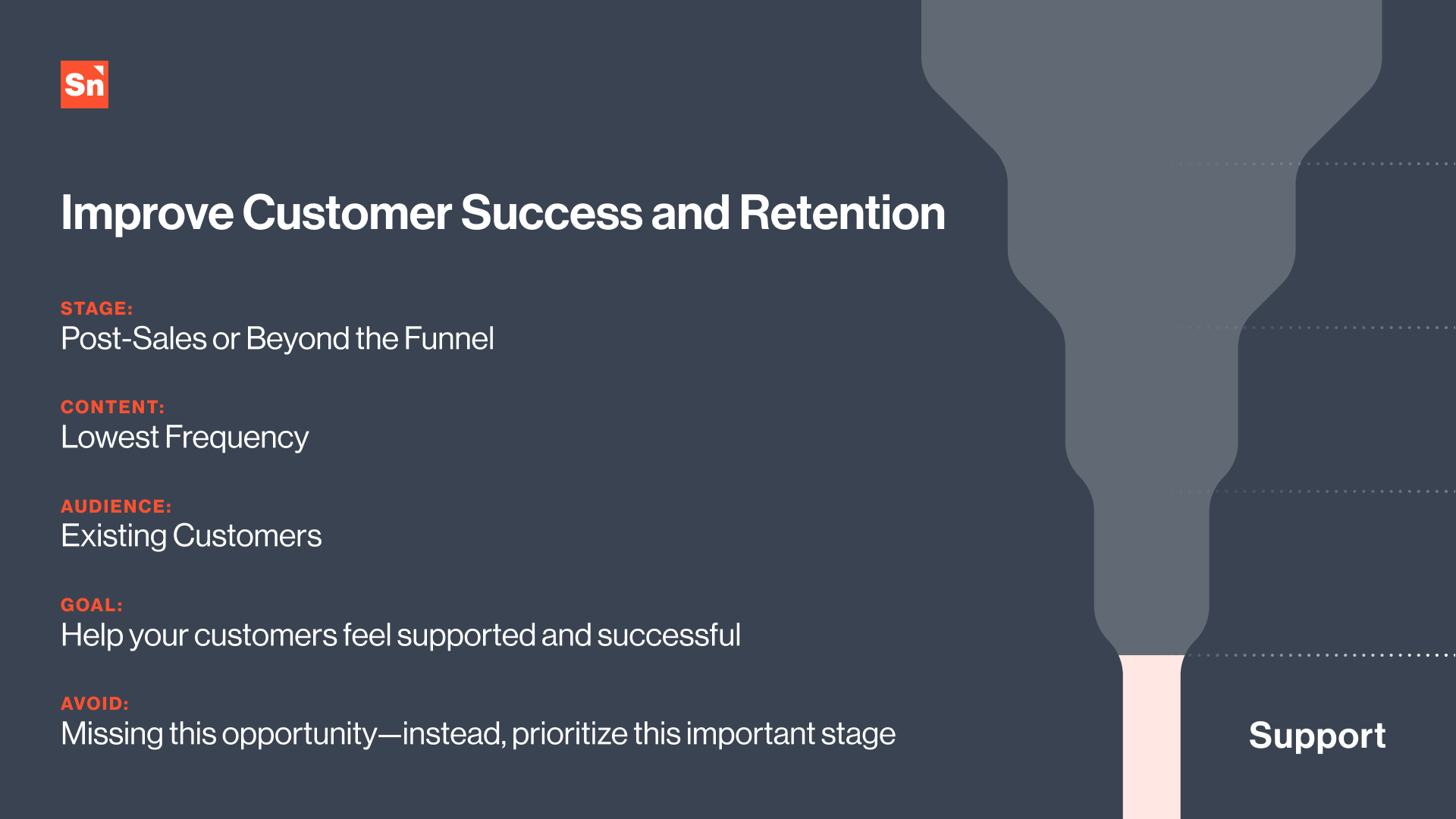
Support Content Ideas
Webinars on new features/solutions
Customer thought leadership
FAQs
Onboarding training
Support community
Support resources
Customer surveys
Support Content Example
For a Support content example, here’s a 20-minute webinar, “Which Power BI License Do We Need?,” from Collectiv that talks in-depth about an important Power BI pricing update.
Power BI licensing is a constant pain for users. Microsoft loves keeping organizations on their toes, making pricing plans extremely complex and difficult to navigate. Collectiv’s “Lunch and Learn” style webinar video breaks down the latest licensing options in great detail to help their customers choose the best Power BI license for their enterprise team.
You Need to Get In Step With Your Buyers
Sometimes we get caught up in who we are as a brand and where we’re headed as an organization. But what about them? We need to understand who our buyers are, where they’re coming from, and where they want to go.
Content that is “all things to all people” isn’t valuable…it’s vague. If your content doesn’t answer your buyer’s questions, they will move on to someone who gives them the answer they’re searching for.
To get the most out of your content strategy, create content that best serves your prospects and future customers. If you’re in step with their specific needs at specific moments, buyers will take notice and appreciate the value you’re already providing.
